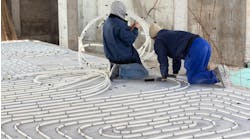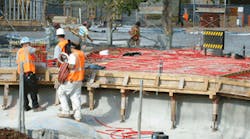Latest from Radiant
eBook: Nelson Mechanical Stories - Volume 1
Sponsored
Denver Zoo’s new exhibit utilizes renewable energy, keeps animals comfy
DENVER — At the new Denver Zoo Asian Tropics exhibit, which will include the largest elephant habitat in the country, a biomass gasification system is expected to save $150,000 a year in energy and waste hauling costs by converting more than 90% of the zoo’s waste into clean, usable energy on site. Use of this system will also reduce the zoo’s landfill contributions by 1.5 million pounds per year and help the zoo close in on its goal to become a zero-waste facility. The design calls for radiant flooring in animal holding facilities and uses recycled water for the outdoor pools to ensure elephants and other animals in the exhibit live in comfort while minimizing the impact to the environment.
Tiffany Barnhart, director of communications at the Denver Zoo, told CONTRACTOR that the zoo has been a leader in sustainability for many years and it wants to take its sustainability efforts to the next level by incorporating renewable energy and becoming a zero-waste facility.
“One of our core values at the zoo is innovation, so we were eager to find a creative solution that helped us meet all of our needs,”said Barnhart. “The concept of converting our waste stream into clean energy and investigating more aggressive technologies sprung from this.”
Waste equals energy
The zoo spent three years researching gasification systems that could meet the scale and waste stream criteria at the zoo.
Research included evaluating the quantity, composition and energy content of all waste streams, including concession waste, hay, animal food and animal waste to quantify the available energy in the zoo’s waste stream related to the season and visitor count. Computer simulation models of the gasification system were also used to test various components of the operation and evaluate their individual and systematic characteristics. The zoo partnered with the National Renewable Energy Lab in nearby Golden, Colo., which provided assistance in the evaluation of gasification technologies.
The Denver Zoo staff was instrumental in designing the system and will be leading the system installation efforts in the upcoming months. As the waste-to-energy system design nears completion, zoo staff is gearing up for component testing which will be closely followed by system installation and start-up.
Waste will be measured, mixed and processed prior to being sent to the gasifier. The gasification system will create both electricity and heat by using a high temperature, low oxygen process to chemically convert the waste stream into a combustible gas. The system will meet stringent emissions standards and will produce only one byproduct, ash, which will be used as a soil additive in flower beds.
To supplement the gasification system, a boiler plant consisting of four gas-fired, 500,000 Btuh high-efficiency condensing boilers is located within the exhibit grounds. The Aerco boilers are designed to provide 120°F heated water to the buildings in the exhibit.
“Heat energy created by the gasification system will be transferred to large thermal storage tanks using a glycol solution,” said Peter Eades, lead mechanical project engineer at The RMH Group, the project’s mechanical and electrical engineering consulting firm. “A heat exchanger will transfer up to 10 million Btuh from the gasification system to the heating water system.”
Pumps in the boiler plant distribute heated water to various buildings throughout the Asian Tropics exhibit. This hot water is distributed using REHAU’s INSULPEX pre-insulated crosslinked polyethylene (PEXa) pipe, as well as EVERLOC and FUSAPEX fitting systems.
The gas-fired boilers will be used when the heat from the gasification system cannot maintain the required heating water supply temperature.
“During peak heating season the gasification system may not meet 100% of the exhibit heating needs,” said Eades. “Much of the capacity will be dedicated to maintaining the water temperature in the ponds at an acceptable level for the elephants and any additional gasification system capacity beyond that will likely not meet the heating needs in winter. The gasification system will be fed entirely from the zoo waste stream. Since zoo attendance typically peaks in the summer and bottoms out in winter, waste streams are generated counter cyclically to demand. So, since feed stock (waste) for the gasification system is anticipated to be lowest when heating demand is greatest, then the boilers are anticipated to run for much of the winter. However, they are very efficient and staged, so they will use relatively little natural gas compared to older systems.”
Radiant heat for animals
To ensure the animals are comfortable in their holding facilities and that walkways around several of the exhibit buildings are safe to walk on for visitors and employees during the winter months, the zoo is using PEX-based radiant heating and snow and ice melting systems.
The hot water system will be served from the new gas-fired boiler plant that will eventually be supplemented with the new gasification system, according to Porter May, Heating & Plumbing Engineers Inc., the project’s mechanical contractor, and REHAU’s INSULPEX energy transfer pipe was selected because it met the specification requirements and design intent of the project.
“The REHAU INSULPEX will carry hot water that interfaces with the conventional closed- loop hot water system via a heat exchanger,” explained May. “We are providing the heated hot water (HHW) storage tanks and the heat exchanger that the future gasification system will utilize to interface with the conventional HHW system. The hot water storage tanks were custom made to order by Wheeler Tank Mfg. and the heat exchanger is by Mueller.”
May told CONTRACTOR that the radiant heating system was chosen as a highly energy efficient way to heat large indoor animal holding areas.
“REHAU’s RAUPEX was used for all the zoo’s indoor radiant heating and snowmelting areas,” said May. “In total, just under 15,000-ft. of ½-in. RAUPEX O2 barrier pipe was used for the radiant systems, and a little more than 13,000-ft. of 5/8-in. RAUPEX O2 barrier pipe was used for the snowmelting. Also, nearly 3,000-ft. of the large-diameter pre-insulated INSULPEX was used to distribute the HHW underground, from the new boiler plant to the various buildings, etc. The 5-in. (125 mm) INSULPEX pipe, used for the first time in North America on this job, was directly sourced from Germany, and was a last minute change given the dynamic requirements of the project. As a whole we found the PEX industry uses nominal (English I.D. in inches) sizes that are actually smaller than the sizes The RMH Group originally specified when calculating for a rigid piping system. The type of large fittings specified also changed once the new REHAU FUSAPEX, an electrically fused fitting system, became available in the North American market.”
May said that while large pre-insulated pipe can be challenging to work with because it stores energy like a spring, this is easily accommodated for on the job. The flexible nature of the INSULPEX piping, particularly when compared with an alternative material such as pre-insulated copper or steel, was a necessity when working around the zoo’s existing utilities, such as life support, plumbing, and electrical piping.
According to May, a rigid piping system would just not have been an option, given the gains and losses of elevation, as well as the severe angles that the underground piping needed to conform to on the project.
“While its pre-insulated nature is overall more convenient onsite, it can be more cumbersome to handle than non-insulated pipe, even in warmer outdoor temperatures,” said May. “PEX pipe, because it is flexible, offers the advantage of minimizing the need for fittings, though in some of the tighter quarters on this job, such as around footings, etc., fittings became necessary, and we did need to repair the fittings machine at one point. As previously mentioned, the nominal dimensioning created some translational communication issues and we had to make sure everyone on the job was talking about the same pipe diameter sizes before installing them. Overall though, the Rehau system is probably as good as it gets in this category.”
May said that there were many unique aspects to this project, including trying to avoid underground high points while maintaining a minimum 5-ft. depth to prevent the elephants from digging up the pipe. They apparently can hear the water flow and they are curious animals and like to explore.
Recycled water equals conservation
Besides having comfortable holding facilities, the elephants, rhinos and tapirs will also have amenities such as mud wallows, scratching trees, shade structures and swimming and bathing pools. The deepest foundation in the exhibit includes 20-ft. deep settling chambers for the 900,000-gal. of water [according to Denver Zoo, the ponds will hold 1.1 million gallons] recirculated to the outdoor pools. Water for the pools will come from Denver Water’s recycled water system.
According to Barnhart, the Asian Tropics exhibit will hold more water than the rest of the zoo combined. However, the impact will be minimal, since a filtration system and recycled water are being utilized.
“This water will circulate through a complex filtration system that will settle solids, filter and disinfect the water in a continuous cycle, allowing us to maintain the water in the pools for a few months at a time,” said Barnhart. “Denver Water supplies the recycled water for use in the exhibit. We at the Denver Zoo have worked with our lead veterinarian to determine whether or not the recycled water is suitable for animal consumption. After thorough study, we found that Denver’s recycled water quality is very high due to the disinfection process it undergoes before being distributed. Denver’s recycled water is safe and currently, is used in some animal areas at the zoo.”
Other water conserving features at the exhibit are Zurn ultra-low consumption urinals, and American Standard low-consumption toilets with Sloan dual-flush flushometers in the visitor restrooms.
Related Articles:
Cincinnati Zoo conserves resources via 1.56 MW solar array, LEED buildings
Related Articles:
Happy Hollow renovation reduces operating costs
Candace Roulo
Candace Roulo, senior editor of CONTRACTOR and graduate of Michigan State University’s College of Communication Arts & Sciences, has 15 years of industry experience in the media and construction industries. She covers a variety of mechanical contracting topics, from sustainable construction practices and policy issues affecting contractors to continuing education for industry professionals and the best business practices that contractors can implement to run successful businesses.


